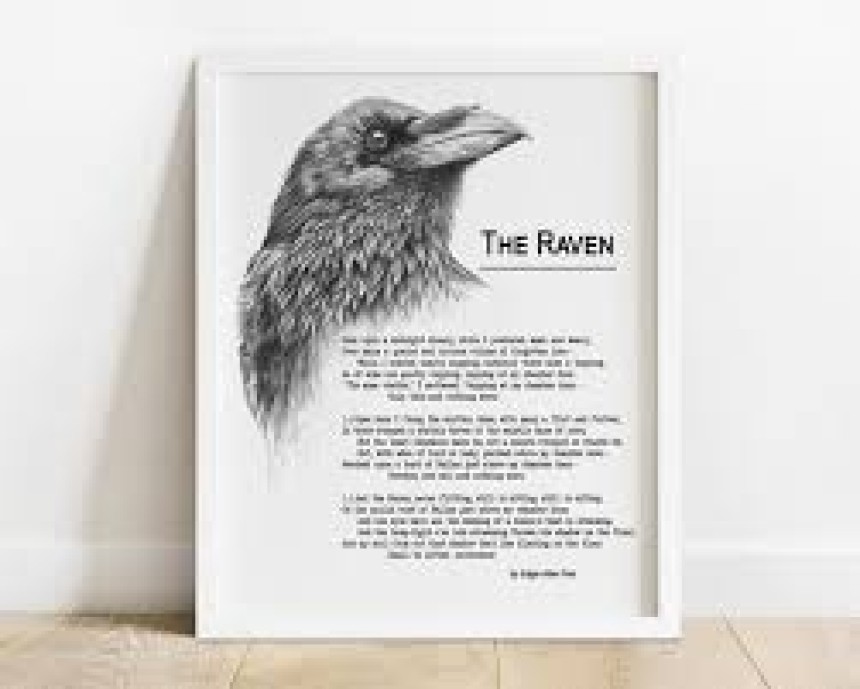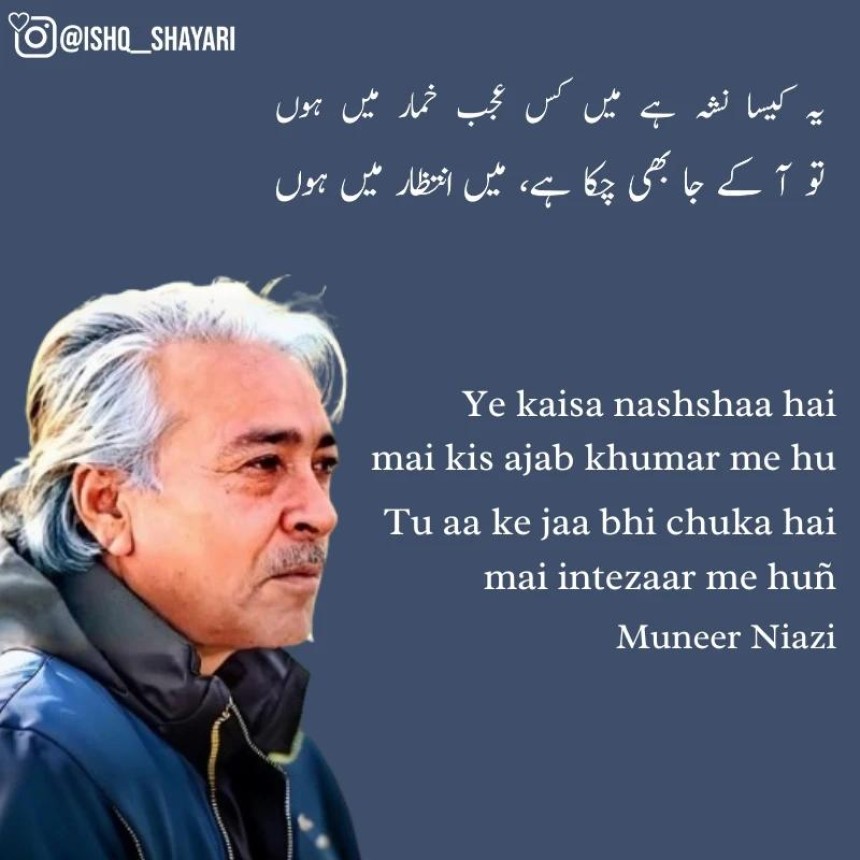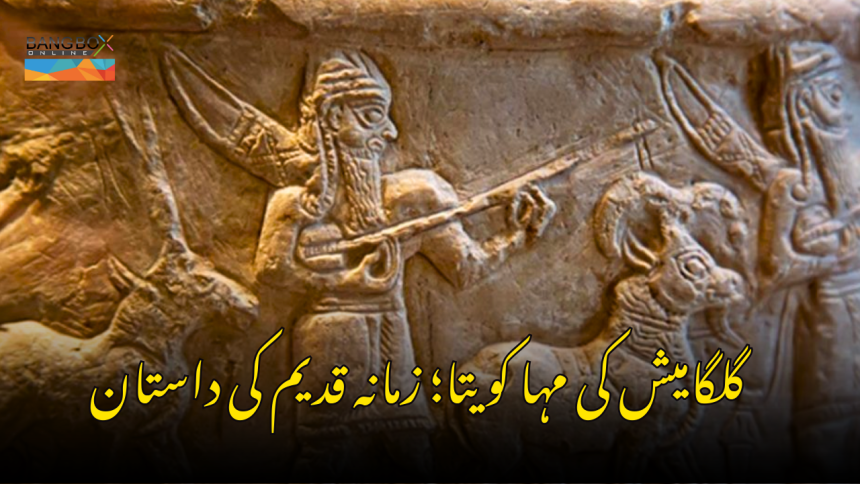
Edgar Allan Poe & Munir Niazi - Strange Correlation
Edgar Allan Poe and Munir Niazi were poets from two different eras, countries, times and have lived a different lives. However, there are strange similarity in their works. This write up is an attempt to explore the commonality and strange correlation between the poetic works of the two.
In the name of ALLAH, the Most Gracious, the Most Merciful
Edgar Allan Poe & Munir Niazi - Strange Correlation
Edgar Allan Poe (January 19,1809 - October 7,1849) was an American writer, poet, editor, and literary critic who was born in Boston, Massachusetts, United States. He is best known for his poetry and short stories, particularly his tales involving mystery and the macabre. Edgar Allan Poe's tumultuous life greatly influenced his writing. He experienced numerous personal losses, battled inner demons, and struggled with addiction throughout his life. These experiences seeped into his works, giving them a unique and chilling authenticity.
Edgar Allan Poe is probably best known for inventing the detective fiction genre with stories such as " The Murders in the Rue Morgue '' (1841) and " The Purloined Letter '' (1845). He also wrote several iconic poems including ``The Raven'' (1845), which has become synonymous with his death itself.
"The Raven" is a narrative poem by Edgar Allan Poe. First published in January 1845, the poem is often noted for its musicality, stylized language and supernatural atmosphere. It tells of a distraught lover who is paid a visit by a mysterious raven (crow as we know in many parts of the world) that repeatedly speaks a single word. The poem explores how grief can overcome a person's ability to live in the present and engage with society. Over the course of the poem, the speaker's inability to forget his lost love "Lenore" drives him to despair and madness.
In the poem "The Raven," Edgar Allan Poe used the raven itself as symbolism. A white raven is often a symbol of good luck. Edgar Allan Poe's use of a black raven might represent the underworld or death. Poe also used metaphor, comparing the raven to a prophet, as well as to angels and demons. More specifically, this poem explores the effects of death on the living, such as grief, mourning, and memories of the deceased, as well as a question that so often torments those who have lost loved ones to death: whether there is an afterlife in which they will be reunited with the dead.
RAVEN by Edgar Allan Poe
Once upon a midnight dreary, while I pondered, weak and weary,
Over many a quaint and curious volume of forgotten lore—
While I nodded, nearly napping, suddenly there came a tapping,
As of some one gently rapping, rapping at my chamber door.
“’Tis some visitor,” I muttered, “tapping at my chamber door—
Only this and nothing more.”
Ah, distinctly I remember it was in the bleak December;
And each separate dying ember wrought its ghost upon the floor.
Eagerly I wished the morrow;—vainly I had sought to borrow
From my books surcease of sorrow—sorrow for the lost Lenore—
For the rare and radiant maiden whom the angels name Lenore—
Nameless here for evermore.
And the silken, sad, uncertain rustling of each purple curtain
Thrilled me—filled me with fantastic terrors never felt before;
So that now, to still the beating of my heart, I stood repeating
“’Tis some visitor entreating entrance at my chamber door—
Some late visitor entreating entrance at my chamber door;—
This it is and nothing more.”
Back into the chamber turning, all my soul within me burning,
Soon again I heard a tapping somewhat louder than before.
“Surely,” said I, “surely that is something at my window lattice;
Let me see, then, what thereat is, and this mystery explore—
Let my heart be still a moment and this mystery explore;—
’Tis the wind and nothing more!”
Then this ebony bird beguiling my sad fancy into smiling,
By the grave and stern decorum of the countenance it wore,
“Though thy crest be shorn and shaven, thou,” I said, “art sure no craven,
Ghastly grim and ancient Raven wandering from the Nightly shore—
Tell me what thy lordly name is on the Night’s Plutonian shore!”
Quoth the Raven “Nevermore.”
Much I marvelled this ungainly fowl to hear discourse so plainly,
Though its answer little meaning—little relevancy bore;
For we cannot help agreeing that no living human being
Ever yet was blessed with seeing bird above his chamber door—
Bird or beast upon the sculptured bust above his chamber door,
With such name as “Nevermore.”
Since it's the narrative poem and it is not in few verses, so the interested reader may read the detailed in following link:-
https://www.poetryfoundation.org/poems/48860/the-raven

Munir Niazi, the Pakistani Poet
Munir Niazi, was a Pakistani poet ( April 19, 1928 - 26 December 2006). He was born on April 19, 1928 in a Pashtun family in the town of Khanpur in Hoshiarpur of pre partition Indian sub continent. Munir Niazi was one year old when his father died. He was raised by his mother and maternal uncles. His mother was fond of reading books and it was from her that literary traits were transferred to Munir Niazi.
Munir Niazi passed the matriculation exam and got employed as a sailor in the Royal Indian Navy. But the strict discipline was against his temperament. However, during those days of Naval service, he used to sit alone on the beaches of Bombay and read the stories of Saadat Hasan Manto and the poems of Meeraji published in a magazine named "Adabi Dunya". During those days, his literary passion developed and he resigned from the Navy service and completed his studies and started writing regularly. Nevertheless, from childhood, whenever something surprised Munir, he tried to turn it into a poetic event.
Post independence from Britain, Munir Niazi's family migrated to Pakistan. He later graduated (BA) from Dayal Singh College, Lahore. He also wrote some English poems during the graduation period in University. He wrote songs for films also after graduation. However, Munir Niazi mostly wrote in the Punjabi and Urdu languages in later half part of his life. Munir Niazi was a frequent drinker and considered alcohol bad for everyone but himself. In his late life, he developed a respiratory disease and died of that disease.
In the poetry of Munir Niazi, the internal conditions, feelings and intensity of pain have been described in great details. In his poetry, there is an echo of emotional reflection and mental chaos. In his poetry, loneliness, sadness and memorable moments of the past are imminent. Munir Niazi's poetry often reflects a person's inner state of anxiety and suffering. Fear and loneliness is the most vibrant factor and seen spread everywhere in Munir Niazi's poetry.
If one goes through the compilation of his poetic works, it comes out that fear, fright and horror probably due to his feelings of being alone, despite being among a crowd of acquittances, he remained aloof and lonely. Because of this, he tied himself with imaginary fences like witches and snakes for a lifetime. Mention of desolate places, un populated shelters and the desolation found in them are common in his poetry with associated pitch darkness, the storms of wind and rain; thus portraying his own loneliness.
In the following a free English translation of his poem "Sada Ba-sahra"; " Cry in the Desert" is being shard to show relevance:-
There is darkness and roaring dark clouds everywhere;
She asks " who is there?"
I answered "me";
Open the heavy door;
let me get in;
Then there was no answer and only the strong wind was making noise.
In another couplet of verses he is so despair and clear in his anger as shown below:-
This heartless city should be burned;
Then its dust should also be blown away.
If we do not find shelter in a land;
Then that land must be erased in a doomsday manner.
In a song of a film he wrote following couplets of verses:-
What difference does it make; whether I live or die?
So what; if I pass away from the world quietly?
What is my entity itself in comparison of the world?
I am only a dream; so let it be scattered all over then what?

The Strange Correlation?
There is a deep similarity between the poetry of Edgar Allan Poe and Munir Niazi. Although both were inhabitants of different worlds. Both were born in different eras; As Munir Niazi was born almost 80 years after the death of Edgar Allan Poe. Edgar Allan Poe died at the age of just forty years and Munir Niazi lived twice as old as almost 80 years. Edgar Allan Poe lived in the 1st world country of Western civilization and Munir Niazi lived in the third world country of the Eastern civilization.
Edgar Allan Poe and Munir Niazi were from two different eras. There were inhabitants of different civilizations, traditions and countries; And both found different times, but perhaps the souls of both had emerged from the same source. Both drew similar conclusions from very different situations and events which they both experienced and perhaps strangely expressed the same expression. Both have the same fear in the poetry and anger. There is isolation, mystification and a surprisingly dismissive attitude as well.

How to Style Your Favorite Suicideboys Merch for Everyday Looks
Suicideboys, the rap duo known for their edgy lyrics and distinctive aesthetic, have built...


